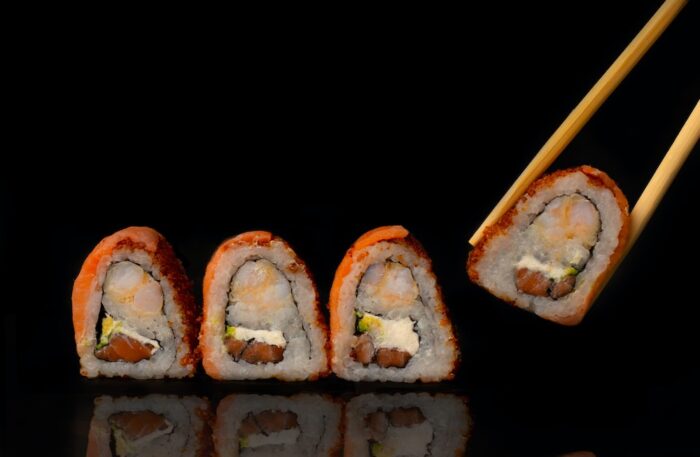Sushi has become an increasingly popular food around the world in recent years. What was once an exotic delicacy is now a staple menu item at many restaurants. While sushi’s popularity has introduced more diners to this Japanese cuisine, it has also led to the development of more modern and experimental sushi rolls that diverge from traditional sushi. In this article we talk about Exploring Traditional Sushi vs. Modern Sushi Rolls.
In this blog post, we’ll explore the differences between traditional sushi and modern sushi rolls. We’ll cover their ingredients, preparation methods, taste profiles, and presentation to understand how modern sushi has adapted traditional techniques into new innovations.
The Origins of Sushi
Sushi has a long and storied past tracing back centuries in Japanese culture. The earliest forms of sushi originated as a way to preserve raw fish by fermenting it with rice. This process allowed raw fish to last longer before refrigeration was available. The rice was thrown away, and only the preserved fish was consumed. This early version of sushi eventually evolved into “narezushi” which involved wrapping freshly caught fish with soured fermented rice in a process known as lacto-fermentation.
By the early 19th century, this fermentation process was shortened. Rice vinegar rather than the lactic acid from fermentation gave the rice its signature sour taste. This new fast-tracked sushi preparation helped popularize sushi since the fermentation period was reduced from months to just a few hours. Here the slices of raw fish and rice eventually became what we know today as “nigiri sushi” – the foundational sushi still enjoyed today in its various forms.
Traditional Sushi Ingredients
The core ingredients of traditional sushi include sushi rice and fresh raw seafood.
Sushi Rice
The rice used in sushi requires special Japanese short-grain white rice that becomes sticky when cooked. The rice is seasoned with a sweetened vinegar mixture that’s cooled before using. Besides white rice, traditional sushi may also incorporate whole grain brown sushi rice for added texture and nuttiness.
Raw Seafood
Fillings like roe, octopus, eel, and sea urchin can also be used as fillings in traditional types of sushi. Vegetarian fillings are also common like cucumber, pickled daikon radish, shiitake mushrooms, and sweet tamago (cooked omelet).
Traditional Sushi Types
There are various traditional sushi types that are still popular today:
Nigiri-zushi – This traditional hand-pressed sushi is an oblong mound of rice with a topping of seafood or vegetable. It’s the foundational sushi style born centuries ago.
Maki-zushi – Translated as “rolled sushi,” this is where rice and fillings are rolled up in sheets of seaweed such as crisp nori. The maki sushi roll can be cut into bite-sized wheel pieces.
Temaki-zushi – Also known as hand rolls, this is where seaweed and rice are wrapped into a hand-held cone shape to be eaten.
Chirashi-zushi – This translates to “scattered sushi” since it’s a bowl of rice topped with a colorful medley of seafood and vegetables.
Oshi-zushi – This unique style involves a wooden mold to press layers of rice and fillings into a compact shape before slicing.
Inari-zushi – Named after the Shinto god Inari, this sushi style involves sweet fried tofu pouches stuffed with rice alone.
The Traditional Sushi Experience
Beyond ingredients and preparation, traditional sushi also represents a purist approach to letting high-quality fresh seafood shine. Traditional sushi is free of heavy sauces and loud flavors that might mask subtler tastes. Instead, it aims to present clean delicate flavors from the sea.
This also means traditional sushi is light on the rice as too much can dampen more delicate fish. The rice should complement rather than overwhelm. Texture also matters so fish should have an ideal smooth, tender bite. Each ingredient from the rice’s vinegar to the snap of crisp seaweed works in harmony.
This balance lends traditional sushi a more nuanced refined flavor profile. It’s understated yet complex allowing natural tastes to speak for themselves through perfect simplicity.
Modern Sushi Innovations
While traditional sushi remains beloved, modern sushi has paved new ground. Creative sushi chefs have invented original sushi rolls that fuse new ingredients and reinterpret traditional recipes. This has expanded sushi’s popularity from Japanese restaurants to a diverse range of eateries.
Unique Ingredients
Modern sushi welcomes bolder ingredients like mango, fried chicken, cream cheese, and avocado. There are virtually no limits to proteins used from cooked meats to tofu. Rather than restraint, experimental combinations are encouraged.
Creative Presentations
Modern sushi also focuses more on innovative visual styles. This includes vibrantly colored ingredients, ornate garnishes, and sculpted shapes. Flowers, drizzles of sauce, and carved vegetables transform sushi into edible art.
Themed Fusion Flavors
Sushi chefs also play with themes that fuse Japanese sushi with flavors from around the globe. There’s Mexican sushi with hot sauce and avocado, Thai sushi with peanut sauce, and Philly sushi featuring cream cheese and smoked salmon. These fusion concepts complement familiar sushi with new twists.
No Rules Approach
Rather than formal traditions, modern sushi gives chefs license to follow whims. The emphasis is on surprising combinations of flavors, textures, colors to delight and impress. Diners become adventurers tasting new creations never tried before.
Accessible Sushi
Modern sushi also prides itself on being more accessible to newcomers. Creative rolls spotlight familiar ingredients like chicken and avocado to ease beginners into sushi. Modern sushi is also more abundant on rice to be filling and affordable. The more relaxed vibe invites diners to customize orders.
The Modern Sushi Experience
Where traditional sushi represents generations of refined subtlety, modern sushi offers a spirited escape from convention. It embraces playful chaos in choices rather than formal rituals. The experience promises diners a sense of delight and surprise with unexpected flavor mashups.
Modern sushi rolls make traditional seafood toppings optional rather than essential. Instead, the joy comes from imaginative recipes that fuse sweet, savory, spicy for fireworks of flavors. Textures also contrast from creamy and crunchy while vibrant colors dazzle the eyes. It’s an edible sense of adventure beyond familiar ground.
Traditional vs Modern Sushi Rolls Showdown
While traditional and modern sushi diverge in philosophy, one is not necessarily superior. Each provides its own merits that appeal to different diners.
Those seeking authentic refined Japanese cuisine gravitate to traditional sushi’s pure approach. Its nuanced flavors and delicate bite let the fresh quality of seafood shine. Traditional sushi connects you to ancient culture and time-honored technique.
For more adventurous eaters, modern sushi’s bold innovations prove irresistible. Its colorful constructions and unexpected flavors create a sense of novelty. Modern sushi impresses with artistic visuals while fusion concepts bridge new cultures into familiar forms. Rather than rigid rules, everything becomes possible.
At its core, sushi in all its forms brings people together through food. Traditional sushi honors enduring foundations while modern sushi forges new directions. There’s beauty in both ends of the spectrum when flavors connect and delight. Sushi’s continuing popularity ensures creations will only continue evolving as more diners discover the joys baked or rolled. I sincerely hope you find this “Exploring Traditional Sushi vs. Modern Sushi Rolls” article helpful.

Shreya & Shrenee Srivastava are the talented bloggers behind Gluttony Guilts, known for their focus on healthy and plant-based food and travel content. With over 9 years of experience, they have authored 6,730 posts and gained 37.7K Instagram followers. They are Zomato Verified Connoisseurs and TripAdvisor Level 5 Contributors, establishing their authority and trust in the culinary and travel spheres.
Connect with Us:
Instagram: gluttonyguilts
Facebook: Gluttony Guilts
YouTube: Gluttony Guilts Channel
Discover more at www.gluttonyguilts.com.

